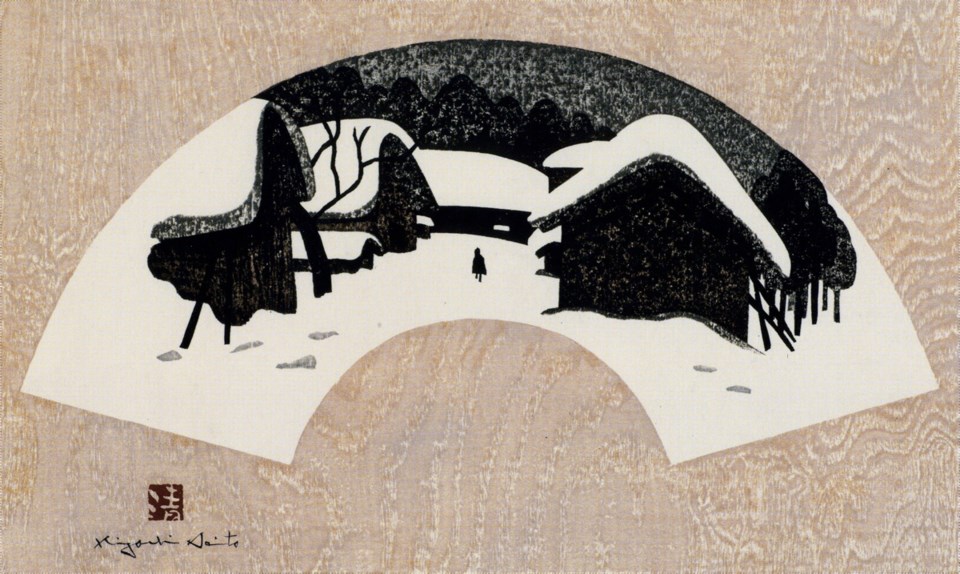Since my arrival here in 1975, I have sung the praises of the Asian art collection at the Art Gallery of Greater Victoria. It seems impossible to make people — locals especially — understand what a treasure house it is. Since that time, the horde has grown in a way that makes Barry Till, curator since 1980, grin like the cat that ate the canary. Till will inevitably retire, and it is by no means certain that the constantly renewed sequence of exhibitions will continue. But while you can, please buy a membership and go, return often, enjoy and be inspired by what this gallery owns and displays for your pleasure.
At the moment, among other delights (the definitive show of etchings by David Blackwood of the Newfoundland outport way of life; the Emily Carr retrospective) you’ll see a room full of Banko ware — quirky and complex Japanese pottery of the 19th and 20th centuries — and the woodcut prints of Kiyoshi Saito.
In 1951, a print by Saito was shown at the first bienniale exhibition of art in Sao Paolo, Brazil, and won first prize, beating out entries in all other media. His triumph over the oil paintings and sculptures shocked the Japanese, who had a condescending attitude to print making. His simple images went on to gain recognition around the world, ensuring the survival of Japan’s modern print movement. Eventually, the Japanese government in 1981 awarded him the Order of the Sacred Treasure, its highest civil honour. Recognition in the West was much quicker in coming.
Sophisticated commercial printmaking traditions of Japan, which in the previous two centuries had fostered the popular and influential ukiyo-e images of Utamaro and Hokusai, were anathema to this coal miner’s son. Saito grew up in poverty in northern Japan, born in 1907. He supported himself by sign painting and, without training, began to carve and print from wood blocks in a rudimentary way. During the 1930s, the influence of western art and modernism resulted in a new Japanese print movement, sosaku hanga, in which the artist was now responsible for all aspects of the creation — design, carving, printing. Saito displayed his work with these artists beginning in 1937, but didn’t sell his first print until 1947.
Of course, the Second World War was not a good time to sell art in Japan, but with the American occupation he found an audience. His combination of contemporary and Japanese tastes fitted perfectly into modern interiors stateside, and solo exhibitions in Washington and Michigan put him in the spotlight. Avidly collected, his imagery became the new face of Japanese art. A wealthy San Francisco matron, Isabel Pollard, caught on in a big way and during the 1960s, bought more than 100 of his rare early works — and gave them all to the Art Gallery of Greater Victoria. Outside Japan (where there is a Saito Museum in Fukushima Prefecture), only the Cleveland Museum has more.
Saito’s prints are sombre in colour and bold in composition. Our extensive group of his Winter in Aizu series — his most sought-after images — draws one in with strong contrasts. Deep snow mounded on rooftops and fenceposts is represented by the untouched white areas of the thick absorbent Echizen hosho paper he favoured. Sonorous shadows of wooden country houses are printed with black sumi ink, mixed to a range of subtle browns with watercolours. Somehow, he effortlessly conveys the silence of snowfall. A mid-range of soft greys is gently introduced in the foreground, and mottled dimness printed from textured wooden blocks implies distant hills and snow-heavy skies.
Saito’s signature textures result from the wood grain, from blocks roughly scratched and gouged, and from his judicious use of overprinted layers of thin colour. His technique is simplicity itself, yet the effect is profound.
Saito’s prints include sublime simplifications of temple architecture, ancient statues, mysterious women … and cats.
Many verge on a reductive abstraction, and in every case, his compositions are calculated for dramatic and telling effect. No matter what your field of creative endeavour, you can find inspiration in the beautiful prints by this marvelous artist.
Masterful Images: The Art of Kiyoshi Saito, at the Art Gallery of Greater Victoria, 1040 Moss St. (250-389-0303, aggv.ca) until Nov. 3.
